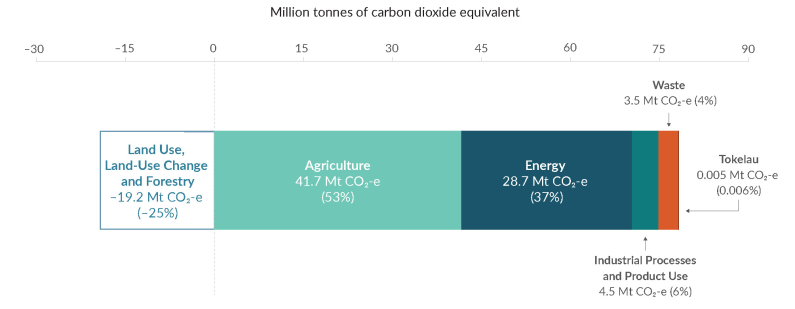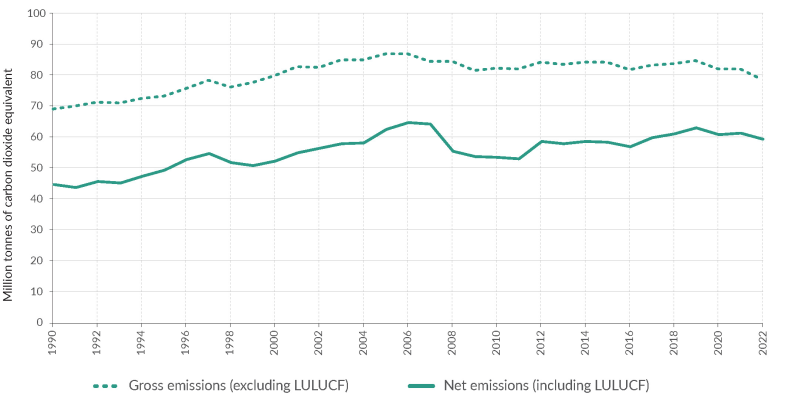New Zealand’s Greenhouse Gas Inventory (1990-2022) shows that gross greenhouse gas emissions decreased by 4 per cent in 2022.
18 April 2024
On this page
New Zealand’s emissions (in Mt CO2-e) by sector in 2022
New Zealand’s gross and net emissions (in Mt CO2-e) from 1990 to 2022
About New Zealand’s Greenhouse Gas Inventory
- Snapshot of New Zealand’s Greenhouse Gas Inventory (1990-2022) (opens in new window)
- New Zealand’s Greenhouse Gas Inventory (1990-2022)
Aotearoa New Zealand’s gross greenhouse gas emissions decreased by 3.4 million tonnes of carbon dioxide equivalent (Mt CO2-e) in 2022, compared to 2021.
3.4 Mt CO2-e is roughly triple the emissions produced by all domestic flights in New Zealand in 2022.
This is the third successive slight decrease year-on-year.
New Zealand’s Greenhouse Gas Inventory is the official annual report of all human-induced emissions and removals produced within New Zealand.
New Zealand’s emissions (in Mt CO2-e) by sector in 2022

Emissions in 2022
- Gross emissions were 78.4 Mt CO2-e. Gross emissions are all emissions from all sectors, except for forests and other land uses (the Land Use, Land Use Change and Forestry sector, or LULUCF).
- Agriculture contributed 53 per cent of gross emissions, followed by the energy sector (including transport), at 37 per cent.
- Emissions were 49 per cent methane, 40 per cent carbon dioxide, 9 per cent nitrous oxide and 2 per cent fluorinated gases.
- Net emissions were 59.2 Mt CO2-e. Net emissions are calculated by adding up all the emissions we produce, then taking off what is absorbed by forests and other land uses. This reflects what is being added to our atmosphere each year by human activities.
- Forestry and other land uses offset 24.5 per cent of New Zealand’s gross emissions in 2022.
Factors affecting emissions in 2022
The biggest reason for the decrease in gross emissions between 2021 and 2022 was an 8 per cent (2.5 Mt CO2-e) decrease in emissions from energy.
This was largely because there was more renewable electricity – mainly hydroelectricity – on the grid. This meant we used less coal and gas, decreasing emissions by 1.7 Mt CO2-e. The proportion of hydroelectricity on the grid in any given year can fluctuate, but wet conditions were good for hydroelectricity generation in 2022.
The closure of New Zealand’s sole oil refinery led to a 0.6 Mt CO2-e decrease in emissions from petroleum refining.
Emissions from road transport decreased by 0.2 Mt CO2-e due to decreased petrol consumption, even though the estimated kilometres travelled by petrol vehicles remained largely stable.
Agricultural emissions decreased by 1.4 per cent (0.6 Mt CO2-e) compared to 2021, because less synthetic nitrogen fertiliser was used, and the number of sheep and beef cattle fell.
New Zealand’s gross and net emissions (in Mt CO2-e) from 1990 to 2022

Emissions since 1990
- New Zealand’s emissions increased between 1990 and 2006, as our economy and population grew.
- Gross emissions peaked at 86.7 Mt CO2-e, and net emissions at 64.6 Mt CO2-e, in 2006. Since 2006, they have been relatively stable, with some fluctuations.
- Since 2019, gross emissions have decreased slightly each year.
- Gross emissions in 2022 were at the lowest annual level since 1999.
- Gross emissions in 2022 were 14 per cent higher, and net emissions 33 per cent higher, than in 1990.
About New Zealand’s Greenhouse Gas Inventory
New Zealand’s Greenhouse Gas Inventory is compiled and submitted as part of Aotearoa New Zealand's responsibilities under the Paris Agreement and the United Nations Framework Convention on Climate Change.
Accurate measurements and reporting of our emissions also informs New Zealand’s climate change decisions.
Emissions reduction targets
Under the Paris Agreement, New Zealand has set a target (opens in new window)to reduce net emissions to 50 per cent below gross 2005 levels by 2030. New Zealand has also set domestic emissions reduction targets.
The Inventory does not track progress towards targets. New Zealand will report information about its Paris Agreement target in the first Biennial Transparency Report, which will be published by 31 December 2024.
The Ministry for the Environment also produces annual estimated projections of emissions to 2050 (opens in new window), which will be updated by December 2024.
Related Content
New Zealand's Greenhouse Gas Inventory
New Zealand's Greenhouse Gas Inventory is the annual report of all human-induced emissions and removals of greenhouse gases in Aotearoa New Zealand.
Greenhouse gas emissions targets and reporting
New Zealand's greenhouse gas emissions targets and how we report on progress towards the targets.
New Zealand’s projected greenhouse gas emissions to 2050
These projections estimate our future greenhouse gas emissions to 2050....
Read the full news release here












